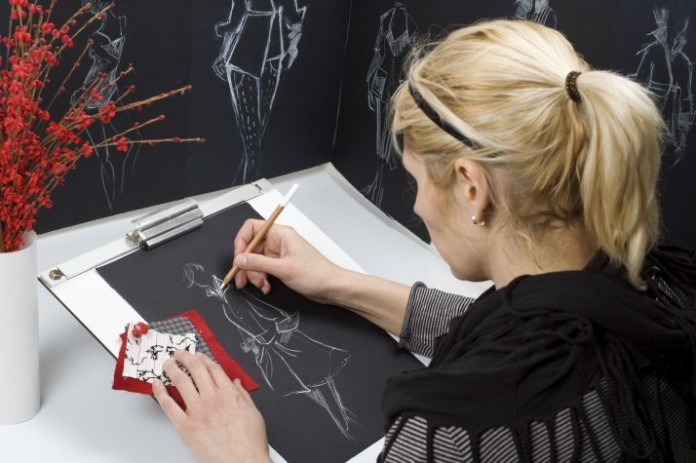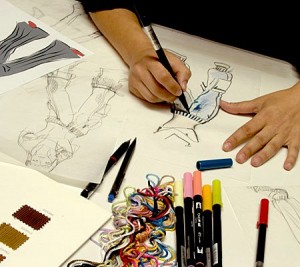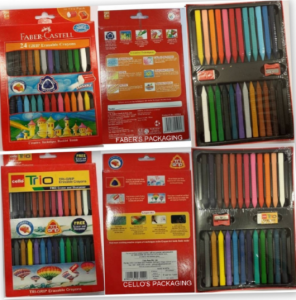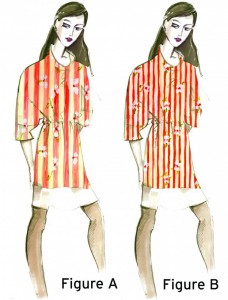In this blog post, Sammanika Rawat and Saurabh Kumar, both students of WB-NUJS, Kolkata, discuss the copyright protection that fashion designers in India can avail for their original work.
Introduction
As per the World Intellectual Property Organization (WIPO), Intellectual Property mainly refers to the legal rights resulting from the intellectual activity in the industrial, scientific, literary and artistic fields[1] which is in intangible form. Copyright in the strict sense refers to the protection of the intellectual creativity in literary, artistic and musical works, etc[2]. The moral basis on which copyright protection rests is ‘Thou Shalt not steal’[3]. In this project, the author shall make an attempt to analyze the principles of Copyright law towards protecting the Fashion Designers with the help of the legislations and their judicial interpretation by the court.
What is Copyright?
In India, copyright is a natural right[4] which comes into existence as soon as a work is created. Copyright is not an absolute right of the owner. Copyright creates an incentive[5] for creating fixed[6] original[7] expression[8]. Balancing the copyright proprietor’s desire to restrict access of his copyrighted works to those willing to pay for such access and the public’s interest in freely using the protected work remains the serious issue under Copyright law[9]. The doctrine of ‘fair dealing’ and the provision for ‘non-voluntary licenses’ in specific situations allow the usage of copyrighted work. Copyright vests in original, literary, dramatic, musical and artistic[10] works.[11] It is the original skill or labor in the execution of the work and not originality of thought, which is required.[12] One may not be liable if he has only taken from the main idea[13] be it original[14]. The law requires the substantial use of expression[15] to presume infringement[16]. Similarity, two different works in itself does not amount to copyright[17] infringement, rather the subject and the source determines the threshold of the infringement. The law provides for both civil[18] as well as criminal remedies for infringement of copyright. The Copyright Act, 1957 is in harmony with the Berne Convention for the Protection of Literary and Artistic Works, 1886 and the Universal Copyright Convention, the Geneva Act, 1952. The term of copyright protection is 60 years.
Protection for Fashion Designers as per judicial pronouncements
It is well known that there are various elements of fashion which are protected under Copyright law[19] such as drawings, photographs of models, jewelry, editorial content, fabric pattern and design software[20], fashion designs which are not always strictly protected. However in Louis Vuitton Malletier v. Atul Jaggi and Another,[21] Delhi High Court recognized copyright of plaintiff in ‘Toile Monogram’ pattern as well as in the Murakami monograms of plaintiff.
The Copyright Act, 1957[22] recognizes artistic work[23], be it in the form of drawing, two dimensional or three dimensional; however Section 15 of the Act restricts copyright in those designs which are registered under the Designs Act, 2000[24]. In Rajesh Masrani v. Tahiliani Design Private Limited[25], Delhi High Court held that since the work was ‘artistic’ in nature, it was not capable of being covered under the Design Act, 2000 and hence Section 15(2) was not applicable. However, in Microfibres, Inc v. Girdhar[26], Delhi High Court held that to be eligible for Designs Act, registration is significant. As per Article 2(5) of the Berne Convention, the collections of literary or artistic works such as encyclopedias and anthologies which, by reason of the ‘selection and arrangement’ of their contents, constitute intellectual creations shall be protected as such, without prejudice to the copyright in each of the works forming part of such collections. In Microfibres[27], another issue which was raised was whether the arrangement of motifs, flowers, leaves and shapes which have been arranged in a particular manner would be applicable for Copyright as ‘labor and skill’[28] was applied to have a particular pattern. Court held that such a work fell out of the scope of ‘artistic work’ as defined under Section 2 (c) of the Act. On a contrary; in Nova Ball Bearing Industries v. Mico Ball Bearing[29], Delhi High Court recognized the copyright in ‘artistic carton’ in which plaintiff packed his items. Similarly in Mother Dairy v. Sri Vinayaka Milk Products[30], Delhi High Court held that the plaintiff’s ‘Mother Dairy’ blue logo and trade dress is an ‘original artistic work’ under Section 2(c) of Act.
The courts have had a favourable response towards recognizing copyright in shapes of the articles. E.g., in Faber-castell Aktiengesellschaft .v Cello Pens Private Limited[31], Bombay High Court while deciding on the case of infringement of copyright of the shape of a crayon set, laid down the following test. It said “Court must have due regard to the overall impact of the rival marks or goods and that the law recognized the importance of the shape in which a trader chooses to sell his goods. Firstly, test is whether the shape adopted by the plaintiff is ‘capricious’, meant purely to give the article a distinctive appearance and characteristic of that particular manufacturer’s goods. Secondly, a conscious imitation by a defendant of the various constituent elements that go into the uniqueness of the plaintiff’s product must lead to a conclusion that confusion and deception are both, respectively, inevitable and intended.” Similarly in Kiran Jogani and Another v. George V. Records, Sarl[32], the Delhi High Court said that the triple criteria of prima facie case, balance of convenience and irretrievable loss and injury required to be fulfilled to establish infringement.
Similarly in William Grant and Sons Limited v. McDowell and Company Limited[33], Delhi High Court recognized copyright in the shape and design of the container of Scotch whisky trade marked as “Glenfiddich”. Delhi High court said that the plaintiff constitutes an original artistic work within meaning of Section 2(c) of Indian Copyright Act, 1957 and hence entitled to protection as such under Indian law by virtue of membership, of both India and United Kingdom, to Berne Convention and Universal Copyright Convention (UCC).
Another interesting case related to fashion designs came to Delhi High Court in 2008[34]. There, the plaintiff was engaged in the business of product lines while defendant was manufacturer and vendor of fashion items. Plaintiff found that each and every print of defendant corresponded exactly with plaintiff’s prints. Plaintiff alleged that defendant attempted to conceal his copying of plaintiff’s work by making minor and insignificant variation in one or two prints. Defendant contended that plaintiff had no right to claim protection under the 1957 Act as the ‘artistic work’ was actually designs relating to textile products, which come under purview of 2000 Act. High Court held that ‘it had been stated by plaintiff that designs were not being mass-produced and it was integral to nature of business of plaintiff that not more than twenty copies were made of any single costume. It stands to reason that plaintiff’s product lines and accessories were known for uniqueness and distinctiveness as creative inputs were required.’ Court emphasized that the uniqueness should not only be in conceptualization but also in creation and presentation as it were sine qua non of haute couture. It also went on to say that the legislature had deemed it expedient to exclude ‘artistic work’ from definition of ‘design’ in 2000 Act and to highlight in 1957 Act. However, it also gave the observation that Copyright in any design which was capable but which had not been registered should cease as soon as any article to which design had been applied had been reproduced more than fifty times by owner. It said that ‘artistic work’, per se, would denote creativity, innovativeness, elegance, exclusivity and like.
The Calcutta High Court in Barbara Taylor Bradford v. Sahara Media Entertainment Ltd[35] explained the rationale behind the basic copyright law which is, ‘you can borrow the idea of another author, but not the expression’. In Anil Gupta v. Kunal Dasgupta[36], court held that ‘if an idea is developed into a concept fledged with adequate details, then the same is capable of protection under the Copyright Act.’ In the particular case, the court cited with approval Fraser v. Thomas Television[37] where the court had observed, ‘I accept that to be capable of protection the idea must be sufficiently developed, so that it would seem to be a concept which has at least some attentiveness for a television programmer and which is capable of being realized as an actuality.’
Conclusion
It is difficult to differentiate the copying of an idea which is permitted and of an expression which is protected. The thin line between the ending of an idea and beginning of an expression is difficult to draw. These are the situations for legal assessment. When we say that an expression must originate from the author and not be copied from another work, the work here is considered to be original when it “owes its origin to the author”[38]. For fashion designers must keep in mind that even if the defendant’s work is found to be substantially similar or even identical to an earlier work, it would still be copyrightable as long as it can be shown by the defendant that he created the work independently of the plaintiff’s work. If the author has utilized the plaintiff’s work, then he must show that he has contributed something more than merely trivial variations, something that can be recognized as his own. At the same time, the author must be able to show some labor, which emerges from his intellect. A drawing which is simply traced from another drawing is not an original artistic work; a drawing which is made without any copying from anything originates with the artist. In case of compilations the courts had held that the labour and skill employed in selecting and arranging existing subject matter gives rise to an original literary work. As Eastern Book Company v. D.B. Modak[39], the Supreme Court held that to claim copyright in a compilation, the author must produce the material with exercise of his skill and judgment which may not be creativity in the sense that it is novel or non-obvious, but at the same time it is not a product of merely skill and labour. The work of compilation must have a flavor of ‘creativity’ to be called original. If a work is created by making use of works in the public domain then ‘sweat of the brow’ test is replaced by ‘minimum of creativity test’.
Footnotes:
[1] WIPO, Intellectual Property Reading Material (1995) p.5.
[2] Alka Chawal, Law of Copyright: Comparative Perspectives (Gurgaon: LexisNexis, 2013)
[3] Macmilllan & Co. LLtd v. Cooper. (1924) 26 BOMLR 292
[4] Registration of copyright is optional. Registration can be done for both published and unpublished work.
[5] Deepak Printery, Ahmedabad v The Forward Stationary Mast 1981 PTC 186 (Guj). Held, the object of the law is to protect authors from exploitation.
[6] Fixation is an important aspect of Copyright.
[7] Copyright law emphasizes on originality. However the threshold of originality has been kept very low.
[8] Copyright law protects expressions and not ideas.
[9] Alka Chawal, Law of Copyright: Comparative Perspectives (Gurgaon: LexisNexis, 2013)
[10] Artistic work may be two dimensional or three dimensional, maps as well as technical drawings.
[11] S.13 Copyright Act 1957.
[12] Supra at 4.
[13] Copyright law does not protect ideas. They are protected under the ‘doctrine of unjust enrichment’, quasi-contract or breach of trust or confidence etc.
[14] Original means the work must be an expression of original thought, University of London press Ltd v University Tutorial Press Ltd (1916) 2 Ch. 601
[15] Northrop Ltd v Textea Blackburn Ltd [1974] R.P.C. 57
[16]Delhi High Court in Zee Telefilms Ltd. v. Sundial Communication 2003 (27) PTC 457 (Bom)(DB) held that when an idea is converted into a concept, it becomes copyrightable.
[17] In so far as it is possible for a person to create same or similar work independently, there is no copyright infringement.
[18] Civil remedies which include injunction, damages and account of profits, delivery of infringing copies and amages for conversion.
[19] Article 2(1) of the Berne Convention states that “The expression “literary and artistic works” shall include every production in the literary, scientific and artistic domain, whatever may be the mode or form of its expression, such as books, pamphlets and other writings; lectures, addresses, sermons and other works of the same nature; dramatic or dramatico-musical works; choreographic works and entertainments in dumb show; musical compositions with or without words; cinematographic works to which are assimilated works expressed by a process analogous to cinematography; works of drawing, painting, architecture, sculpture, engraving and lithography; photographic works to which are assimilated works expressed by a process analogous to photography; works of applied art; illustrations, maps, plans, sketches and three-dimensional works relative to geography, topography, architecture or science.”
[20] Jimenez Guillermo C, Fashion law: A Guide for Designers, Fashion Executives and Attorneys (New York: Fairchild Books, 2nd ed 2014).
[21] Louis Vuitton Malletier v Atul Jaggi and another 2010 Indlaw DEL 1326
[22] Herein after the Act.
[23] As per S.2(c) “artistic work” means-
(i) a painting, a sculpture, a drawing (including a diagram, map, chart or plan), an engraving or a
photograph, whether or not any such work possesses artistic quality;
(ii) work of architecture;7 and
(iii) any other work of artistic craftsmanship;
[24] As per S.15(1) of the Copyright Act 1957, Copyright shall not subsist under this Act in any design which is
registered under the Designs Act, 1911. (2) Copyright in any design, which is capable of being registered under the Designs Act, 1911, but which has not been so registered, shall cease as soon as any article to which the design has been applied has been reproduced more than fifty times by an industrial process by the owner of the copyright or, with his license, by any other person.
[25] Rajesh Masrani v Tahiliani Design Private Limited Indlaw DEL 2023
[26] Microfibres, Inc v Girdhar and Company Others 2006 Indlaw DEL 146
[27] Supra.
[28] Eastern Book Company v D.B. Modak (2008) 1 SCC 1.
[29] Nova Ball Bearing Industries v Mico Ball Bearing 1980 Indlaw DEL 162
[30] Mother Dairy Fruit and Vegetable Private Limited v Sri Vinayaka Milk Products 2015 Indlaw DEL 3680
[31] Faber-castell Aktiengesellschaft, Germany and another v Cello Pens Private Limited, Daman and Diu and another 2016 (1) Bom.C.R. 129
[32] Kiran Jogani and Another v George V.Records, Sarl 2008 (155) DLT 739
[33] William Grant and Sons Limited v Mcdowell and Compay Limited 1995 Indlaw DEL 10861
[34] Tahiliani Design Private Limited v Rajesh Masrani 2008 Indlaw DEL 2279
[35] 2003 47 SCL 445 Cal
[36] AIR 2002 Delhi 379
[37] [(1983) All ER 101]
[38] Supra at 9.
[39] Supra at 28.
 Serato DJ Crack 2025Serato DJ PRO Crack
Serato DJ Crack 2025Serato DJ PRO Crack













 Allow notifications
Allow notifications



